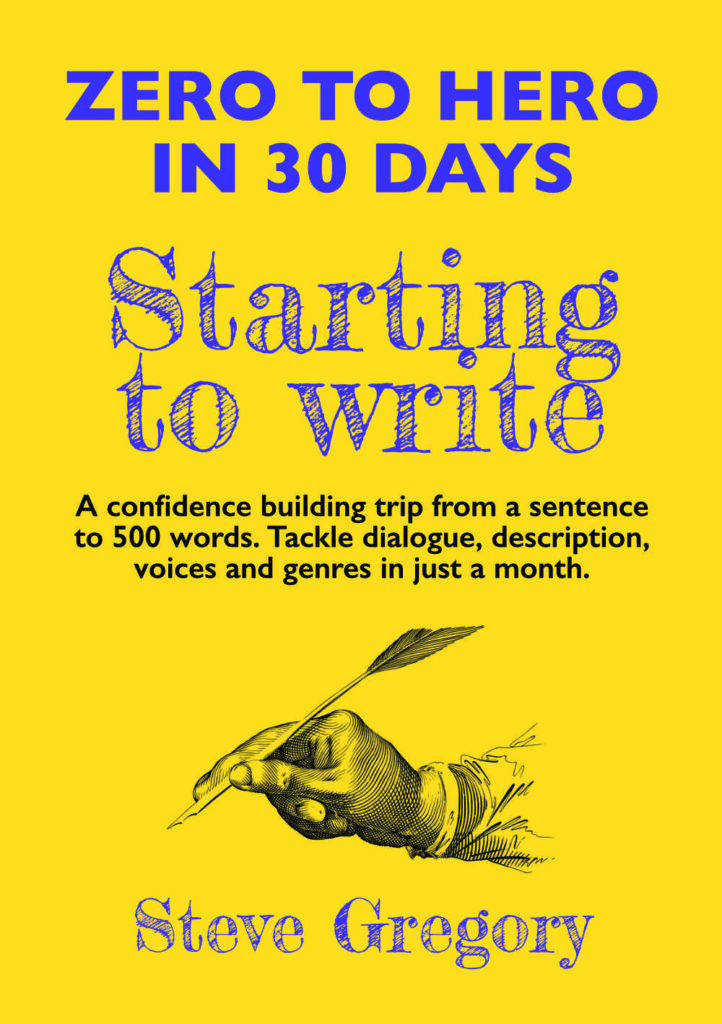It's about telling a story

Day 1 – Your first ten words
Day 2 – The first 50 words
Day 3 – 100 words in 10
Day 4 – Sounding natural
Day 5 – Starting dialogue
Day 6 – Show don’t tell
Day 7 – Writing a place
Day 8 – Writing a character
Day 9 – Managing pace
Day 10 – Editing
Pause for reflection
Day 11 – 200 words
Day 12 – Starting
Day 13 – Finishing
Day 14 – Starting and finishing
Day 15 – Who’s telling the story
Day 16 – Not another narrator
Day 17 – Pick a genre
Day 18 – Pick another genre
Day 19 – A mix of dialogue and place
Day 20 – A mix of dialogue and character
Making and keeping notes
Day 21 – Writing the first 500
Day 22 – 500 of dialogue, the
easiest place to start
Day 23 – 500 of character description
Day24 – 500 describing a place
Day 25 – 500 describing a historical event
Day 26 – 500 of autobiography
Day 27 – 500 words diary entry
Day 28 – Spontaneous writing
Day 29 – A planning session
Day 30 – 500 of your own
That’s the end of the beginning
Examples
Day 6 – Show don’t tell
Objective: We don’t need every minute detail
How many times have you heard it? Show don’t tell. And still we see it in so many novels where the writer feels obliged to give us a total description of a person or a place before a word is spoken or any action takes place.
There are occasions when a person or object needs to be described because that is a vital part of the story, but too often they are actually or virtually inanimate, saying nothing or doing very little. Your sleuth, for example, may be covertly watching a nightclub and describes the gangster/doorman who is never going to be mentioned again. You might ask why you need to describe them in that situation, but we’ll let that go.
A few words in the dialogue or the action tells us so much. Don’t say he walked with a limp, say he limped into the room. Don’t say she had blonde hair, say she played with her blonde hair while she considered his proposal.
Gently, piece by piece, build up an image of the character in the reader’s mind because if you blow it all in one paragraph of description the chances are they will have forgotten most of it within a few paragraphs and you have lost your chance of a more interesting narrative. Our examples become, he walked into the room and she played with her hair. Boring.
Alternatively, let other characters describe the features that stand out. ‘George wondered how he got the limp,’ or ‘He wasn’t deceived by the blonde hair, red pouting lips and fluttering eyelashes.’
Put action into other description. ‘A dozen gulls screamed at each other following the plough as it was hauled across the field at the bottom of the valley,’ rather than ‘A tractor was ploughing a field.’ Such description can be even more useful if it involves the character, ‘John refocused his binoculars to watch a dozen gulls scream at each other as they followed the plough in the valley.’
Fortunately this is one of those tasks where it becomes easier, the quicker you write and allow the character and scene to develop as you write it. Spend too long thinking about it and your work will become blocky and you won’t like it.
Two more benefits, you may find in the future, are that the character you had in mind when you started takes on his/her own personality independent of what you had intended, and, if you keep your description to essentials the reader will create/imagine what they look like. If you’ve ever listened to a radio play or podcast, it is almost inevitable that you created an image of the characters in your head.
Tip: If you overdo the description you are likely to kill the action. If your hero punches someone, you don’t want to wait for 100 words of description before you find out they are unconscious.
Summary: Drop description sparingly into the story and make sure it contributes to the story. You can tell us someone is blonde early on if it is going to be relevant later or it immediately gives us an impression of them. But don’t do it, if you don’t need it.
